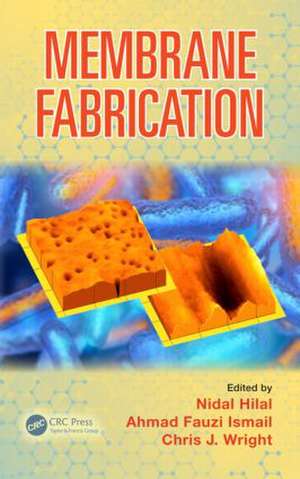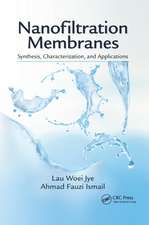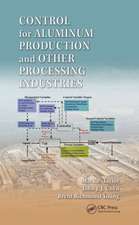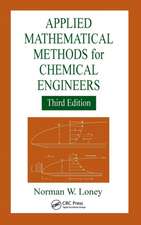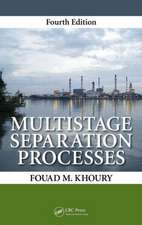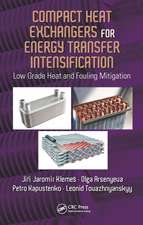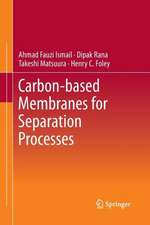Membrane Fabrication
Editat de Nidal Hilal, Ahmad Fauzi Ismail, Chris Wrighten Limba Engleză Hardback – 2 mar 2015
Exploring fabrication processes for polymeric, inorganic, and composite membranes, the book details the effects of different fabrication conditions and how these conditions can be controlled to optimize membrane construction and the subsequent application of the membrane system. It examines the advantages and disadvantages of each type of membrane, including the malleable yet vulnerable polymeric membranes, the robust yet costly inorganic membranes, and composite membranes, constructed with a blend of inorganic and organic materials.
Offering a comprehensive survey of a range of fabrication methods, the book is essential reading for those engaged in the R & D activities of the field, as well as those interested in the sustainable development of membranes for various applications. It is also an important resource for industrialists and others charged with developing and introducing membrane processes into production or waste management.
Preț: 1361.81 lei
Preț vechi: 1826.36 lei
-25% Nou
Puncte Express: 2043
Preț estimativ în valută:
260.66€ • 273.85$ • 219.06£
260.66€ • 273.85$ • 219.06£
Carte tipărită la comandă
Livrare economică 11-25 martie
Preluare comenzi: 021 569.72.76
Specificații
ISBN-13: 9781482210453
ISBN-10: 1482210452
Pagini: 758
Ilustrații: 343 black & white illustrations, 74 black & white tables
Dimensiuni: 156 x 234 x 43 mm
Greutate: 1.18 kg
Ediția:1
Editura: CRC Press
Colecția CRC Press
ISBN-10: 1482210452
Pagini: 758
Ilustrații: 343 black & white illustrations, 74 black & white tables
Dimensiuni: 156 x 234 x 43 mm
Greutate: 1.18 kg
Ediția:1
Editura: CRC Press
Colecția CRC Press
Cuprins
FABRICATION PROCESSES FOR POLYMERIC MEMBRANE. Polymeric Membranes. Electrospinning: A Practical Approach for Membrane Fabrication. Control of Crystallization of Poly(Lactic Acid) Membranes. Innovative Methods to Improve Nanofiltration Performance through Membrane Fabrication and Surface Modification Using Various Types of Polyelectrolytes. Polysaccharides: A Membrane Material. Cellulose and Its Derivatives for Membrane Separation Processes. PVDF Hollow-Fiber Membrane Formation and Production. PVDF Membranes for Membrane Distillation: Controlling Pore Structure, Porosity, Hydrophobicity, and Mechanical Strength. Membrane Contactor for Carbon Dioxide Absorption and Stripping. FABRICATION PROCESSES FOR INORGANIC MEMBRANE. Microstructured Ceramic Hollow-Fiber Membranes: Development and Application. Ceramic Hollow-Fiber Support through a Phase Inversion-Based Extrusion/Sintering Technique for High-Temperature Energy Conversion Systems. Development of Large-Scale Industrial Applications of Novel Membrane Materials: Carbon Nanotubes, Aquaporins, Nanofibers, Graphene, and Metal-Organic Frameworks. Pd-Based Membranes and Membrane Reactors for Hydrogen Production. FABRICATION PROCESSES FOR COMPOSITE MEMBRANE. Current Progress of Nanomaterial/Polymer Mixed-Matrix Membrane for Desalination. Fabrication of Polymeric and Composite Membranes. Strategies to Use Nanoparticles in Polymeric Membranes. Surface Modification of Inorganic Materials for Membrane Preparation. Fabrication of Low-Fouling Composite Membranes for Water Treatment. Fabrication of Polymer Nanocomposite Membrane by Intercalating Nanoparticles for Direct Methanol Fuel Cell. Effects of Solvent and Blending on the Physical Properties of Sulfonated Poly(Ether Ether Ketone): A Promising Membrane Material for PEMFC.
Notă biografică
Nidal Hilal, Ahmad Fauzi Ismail, Chris Wright
Descriere
Membranes play a crucial role in ensuring the optimum use and recovery of materials in manufacturing. This book examines current membrane fabrication methods and how they are used in the optimization of membrane applications. They present innovative ideas on the development of membrane science and technology with a view toward efficient application of membrane separation processes. Exploring fabrication processes for polymeric, inorganic, and composite membranes, the book details the effects of different fabrication conditions and how these conditions can be controlled to optimize membrane construction and the subsequent application of the membrane system.
